Research on the Frequency Stabilization System of an External Cavity Diode Laser Based on Rubidium Atomic Modulation Transfer Spectroscopy Technology
Abstract
1. Introduction
2. Basic Principle
3. Overall Scheme and MTS Signal Optimization
3.1. Overall Scheme
3.2. MTS Signal Optimization
3.2.1. Rb Cell Temperature Regulation
3.2.2. Optical Power Ratio Regulation
3.2.3. Modulation and Demodulation Signal Regulation
4. Experimental Results
4.1. Beat Frequency Test
4.1.1. Laser Linewidth Measurement
4.1.2. Frequency Stability Measurement
4.2. Stabilization Monitoring
5. Conclusions
Author Contributions
Funding
Institutional Review Board Statement
Informed Consent Statement
Data Availability Statement
Acknowledgments
Conflicts of Interest
References
- Hummon, M.T.; Kang, S.; Bopp, D.G.; Li, Q.; Westly, D.A.; Kim, S.; Fredrick, C.; Diddams, S.A.; Srinivasan, K.; Aksyuk, V.; et al. Photonic chip for laser stabilization to an atomic vapor with 10–11 instability. Optica 2018, 5, 443–449. [Google Scholar] [CrossRef]
- Döringshoff, K.; Gutsch, F.B.; Schkolnik, V.; Kürbis, C.; Oswald, M.; Pröbster, B.; Kovalchuk, E.V.; Bawamia, A.; Smol, R.; Schuldt, T.; et al. Iodine Frequency Reference on a Sounding Rocket. Phys. Rev. Appl. 2019, 11, 054068. [Google Scholar] [CrossRef]
- Shen, X.; Yan, M.; Hao, Q.; Yang, K.; Zeng, H. Adaptive Dual-Comb Spectroscopy With 1200-h Continuous Operation Stability. IEEE Photonics J. 2018, 10, 1503309. [Google Scholar] [CrossRef]
- Coddington, L.; Newbury, N.; Swann, W. Dual-comb spectroscopy. Optica 2016, 3, 414–426. [Google Scholar] [CrossRef] [PubMed]
- Meylahn, F.; Knust, N.; Willke, B. Stabilized laser system at 1550 nm wavelength for future gravitational-wave detectors. Phys. Rev. D 2022, 105, 122004. [Google Scholar] [CrossRef]
- Sinhal, M.; Johnson, A.; Willitsch, S. Frequency stabilisation and SI tracing of mid-infrared quantum-cascade lasers for precision molecular spectroscopy. Mol. Phys. 2023, 121, e2144519. [Google Scholar] [CrossRef]
- Li, Q.X. Research on Intelligent Technology of Laser Frequency Automatic Stabilization for Atomic Interferometer. Master’s Thesis, National University of Defense Technology, Changsha, China, 2018. [Google Scholar]
- Lv, M.J. Laser Frequency Stabilization Technology for Transportable Cold Atomic Interference Gravimete. Master’s Thesis, National University of Defense Technology, Changsha, China, 2020. [Google Scholar]
- Zou, P.F. Theoretical Modeling and Error Analysis of Cold Atom Interferometer. Master’s Thesis, National University of Defense Technology, Changsha, China, 2016. [Google Scholar]
- Sheng, L.; Ge, C.; Cao, Q.; Huang, L.; Zhao, Z.; Li, L.; Qiao, S.; Zhang, A.; Wei, Y.; Jin, H.; et al. Wide-range external-cavity tunable semiconductor laser with mode-hopping fre. Infrared Laser Eng. 2023, 52, 160–166. [Google Scholar]
- Wu, Y.; Qin, F.; Li, Y.; Ding, Z.; Xu, R. Designing an Automatic Frequency Stabilization System for an External Cavity Diode Laser Using a Data Acquisition Card in the LabVIEW Platform. Appl. Sci. 2024, 14, 308. [Google Scholar] [CrossRef]
- Luan, G.J.; Mao, H.C.; Shi, X.H. Method for Modulating Transfer Spectrally Stabilized Laser Frequency Based on Rb87. Opt. Optoelectron. Technol. 2020, 18, 83–86. [Google Scholar]
- Preston, D.W. Doppler-free saturated absorption: Laser spectroscopy. Am. J. Phys. 1996, 64, 1432–1436. [Google Scholar] [CrossRef]
- Shirley, J.H. Modulation transfer processes in optical heterodyne saturation spectroscopy. Opt. Lett. 1982, 7, 537–539. [Google Scholar] [CrossRef] [PubMed]
- Bjorklund, G.C. Frequency-modulation spectroscopy: A new method for measuring weak absorptions and dispersions. Opt. Lett. 1980, 5, 15–17. [Google Scholar] [CrossRef] [PubMed]
- Corwin, K.L.; Lu, Z.T.; Hand, C.F.; Epstein, R.J.; Wieman, C.E. Frequency-stabilized diode laser with the Zeeman shift in an atomic vapor. Appl. Opt. 1998, 37, 3295–3298. [Google Scholar] [CrossRef] [PubMed]
- Wieman, C.; Hänsch, T.W. Doppler-Free Laser Polarization Spectroscopy. Phys. Rev. Lett. 1976, 36, 1170–1173. [Google Scholar] [CrossRef]
- Noh, H.R.; Park, S.E.; Li, L.Z.; Park, J.D.; Cho, C.H. Modulation transfer spectroscopy for 87 Rb atoms: Theory and experiment. Opt. Express 2011, 19, 23444–23452. [Google Scholar] [CrossRef]
- Kovachy, T.; Chiow, S.; Kasevich, M.A. Adiabatic-rapid-passage multiphoton Bragg atom optics. Phys. Rev. A 2012, 86, 011606. [Google Scholar] [CrossRef]
- Galzerano, G.; Bertinetto, F.; Bava, E. Characterization of the modulation transfer spectroscopy method by means of He-Ne lasers and 127I2 absorption lines at λ = 612 nm. Metrologia 2000, 37, 149. [Google Scholar] [CrossRef]
- Galzerano, G.; Bava, E.; Bisi, M.; Bertinetto, F.; Svelto, C. Frequency stabilization of frequency-doubled Nd:YAG lasers at 532 nm. In Proceedings of the 1998 Conference on Precision Electromagnetic Measurements Digest (Cat. No.98CH36254), Washington, DC, USA, 6–10 July 1998; pp. 193–194. [Google Scholar]
- Nakagawa, K.; Sato, Y.; Musha, M.; Ueda, K. Modulation-free acetylene-stabilized lasers at 1542 nm using modulation transfer spectroscopy. Appl. Phys. B 2005, 80, 479–482. [Google Scholar] [CrossRef]
- Bertinetto, F.; Cordiale, P.; Galzerano, G.; Bava, E. Frequency stabilization of DBR diode laser against Cs absorption lines at 852 nm using the modulation transfer method. IEEE Trans. Instrum. Meas. 2001, 50, 490–492. [Google Scholar] [CrossRef]
- Xu, Z.; Peng, X.; Li, L.; Zhou, Y.; Qiu, X.; Zhang, D.; Zhou, M.; Xu, X. Modulation transfer spectroscopy for frequency stabilization of 852 nm DBR diode lasers. Laser Phys. 2020, 30, 025701. [Google Scholar] [CrossRef]
- Wang, W.L.; Ye, J.; Jiang, H.L.; Bi, Z.Y.; Ma, L.S.; Xu, X.Y. Frequency stabilization of a 399-nm laser by modulation transfer spectroscopy in an ytterbium hollow cathode lamp. Chin. Phys. B 2011, 20, 013201. [Google Scholar] [CrossRef]
- De Melo, Á.M.; Letellier, H.; Apoorva, A.; Glicenstein, A.; Kaiser, R. Laser frequency stabilization by modulation transfer spectroscopy and balanced detection of molecular iodine for laser cooling of 174Yb. Opt. Express 2024, 32, 6204–6214. [Google Scholar] [CrossRef] [PubMed]
- Yu, F.; Ruan, J.; Wang, X.; Zhang, H.; Liu, D.; Chen, J.; Shi, J.; Zhang, S. Frequency stabilization of DFB laser via modulation transfer spectroscopy. In Proceedings of the Second International Conference on Photonics and Optical Engineering 2017, Xi’an, China, 28 February 2017; Volume 10256, pp. 160–166. [Google Scholar]
- Sharma, L.; Roy, A.; Panja, S.; De, S. Stabilizing Frequency of a Diode Laser to a Reference Transition of Molecular Iodine through Modulation Transfer Spectroscopy. Atoms 2023, 11, 83. [Google Scholar] [CrossRef]
- Cheng, B.; Wang, Z.Y.; Wu, B.; Xu, A.P.; Wang, Q.Y.; Xu, Y.F.; Lin, Q. Laser frequency stabilization and shifting by using modulation transfer spectroscopy. Chin. Phys. B 2014, 23, 104222. [Google Scholar] [CrossRef]
- Sun, D.; Zhou, C.; Zhou, L.; Wang, J.; Zhan, M. Modulation transfer spectroscopy in a lithium atomic vapor cell. Opt. Express 2016, 24, 10649–10662. [Google Scholar] [CrossRef] [PubMed]
- Preuschoff, T.; Schlosser, M.; Birkl, G. Optimization strategies for modulation transfer spectroscopy applied to laser stabilization. Opt. Express 2018, 26, 24010–24019. [Google Scholar] [CrossRef] [PubMed]
- Wu, B.; Zhou, Y.; Weng, K.; Zhu, D.; Fu, Z.; Cheng, B.; Wang, X.; Lin, Q. Modulation transfer spectroscopy for D1 transition line of rubidium. J. Opt. Soc. Am. B 2018, 35, 2705–2710. [Google Scholar] [CrossRef]
- Yan, J.X.; Yan, Y. Light-intensity distribution in the nonlinear medium for near-degenerate four-wave mixing. Opt. Technol. 1998, 1, 73–75+82. [Google Scholar]
- Yu, X.; Lü, M.J.; Zhang, X. Research on Frequency Locking of 1560 nm Fiber Laser Based on Rubidium Atomic Modulation Transfer Spectroscopy Technology. Chin. J. Laser 2022, 49, 15–23. [Google Scholar]
- Song, W.; Zhu, X.X.; Wu, B. Research on Frequency Stabilization Characteristics of Multi -parameter Dependent Laser Source Based on Modulated Transfer Spectrum. Acta Photonica Sin. 2021, 50, 71–79. [Google Scholar]
- McCarron, D.J.; King, S.A.; Cornish, S.L. Modulation transfer spectroscopy in atomic rubidium. Meas. Sci. Technol. 2008, 19, 105601. [Google Scholar] [CrossRef]
- Wu, Y.Y.; Qin, F.J.; Li, D.Y. Design of Multi-point Temperature Measurement System Applied to MTS. Instrum. Tech. Sensos 2023, 1, 73–77. [Google Scholar]
- Wang, X.P.; Wang, J.H.; Lin, Z.X. Design of iodine discriminator temperature measurement systems. Transducer Microsyst. Technol. 2015, 34, 63–65. [Google Scholar]
- Yan, J.Q.; Zhang, Y.; Hou, F.Y. Temperature dependence of Rb D2 line in saturation spectroscopy. J. At. Mol. Phys. 2008, 25, 1057–1062. [Google Scholar]
- Steck, D.A. Rubidium 85 D Line Data; 2001; pp. 1–31. Available online: https://steck.us/alkalidata/rubidium85numbers.pdf (accessed on 1 February 2024).
- Steck, D.A. Rubidium 87 D Line Data; 2003; pp. 1–29. Available online: https://steck.us/alkalidata/rubidium87numbers.1.6.pdf (accessed on 1 February 2024).
- Jia, Y.D.; Lin, Z.L.; Ou, P.; Zhang, C.X. Optimization of electro-optical parameter of optical frequency standard system based on modulationtransfer spectroscopy technique. Acta Phys. Sin. 2011, 60, 124214. [Google Scholar] [CrossRef]
- Ma, Z.; Lu, X.G.; Pei, L.Y. Monitoring the Frequency Locking by Recording the Beat Notes between Two Independent Laser. J. Qufu Norm. Univ. 2013, 39, 63–66. [Google Scholar]
- Liu, T.; Ma, X.; Zhang, S.; Ren, G. Measurement of Frequency Stability of Two Independent Lasers with the Same Mode. Chin. J. Lasers 2012, 39, 174–178. [Google Scholar]
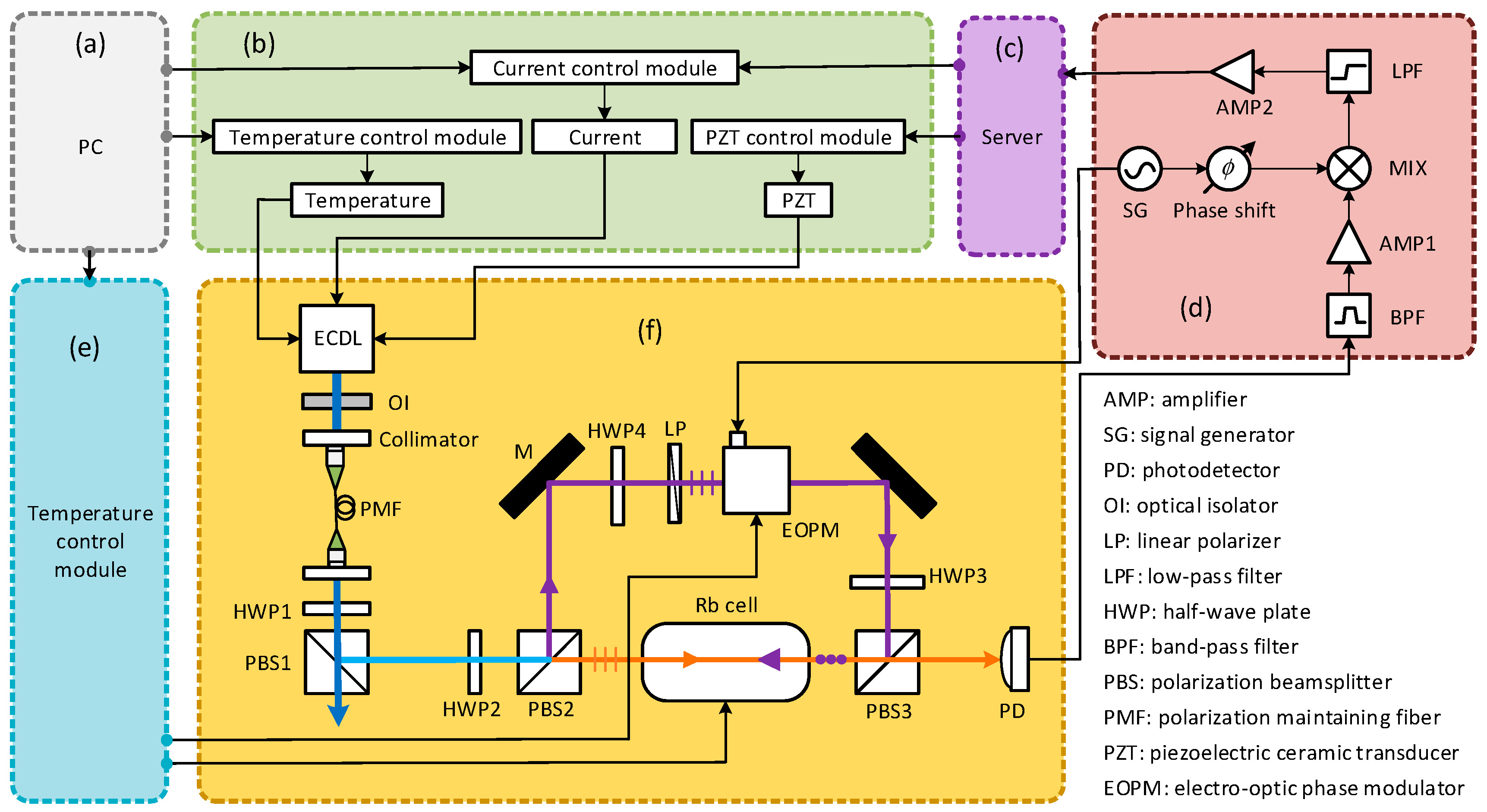
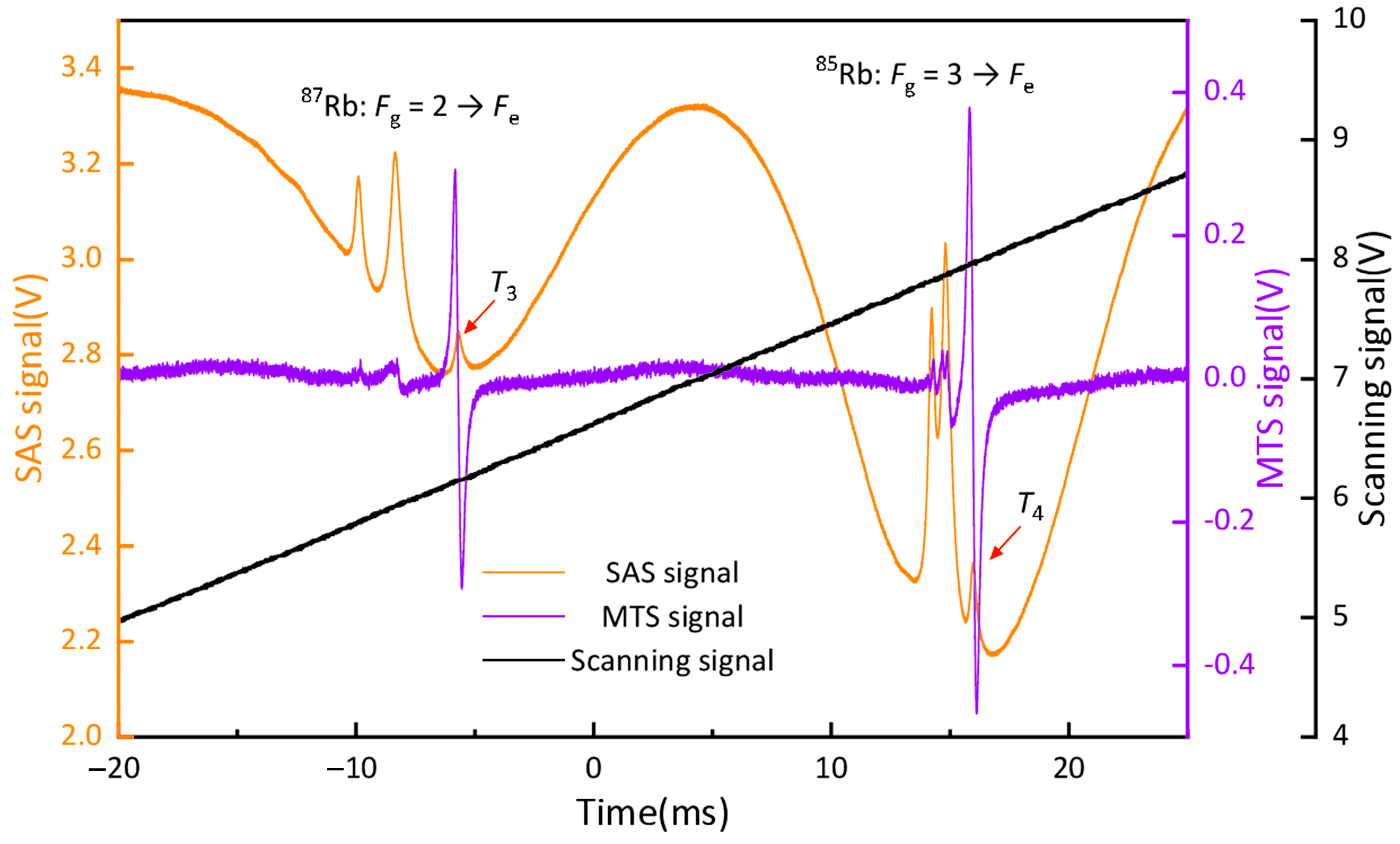
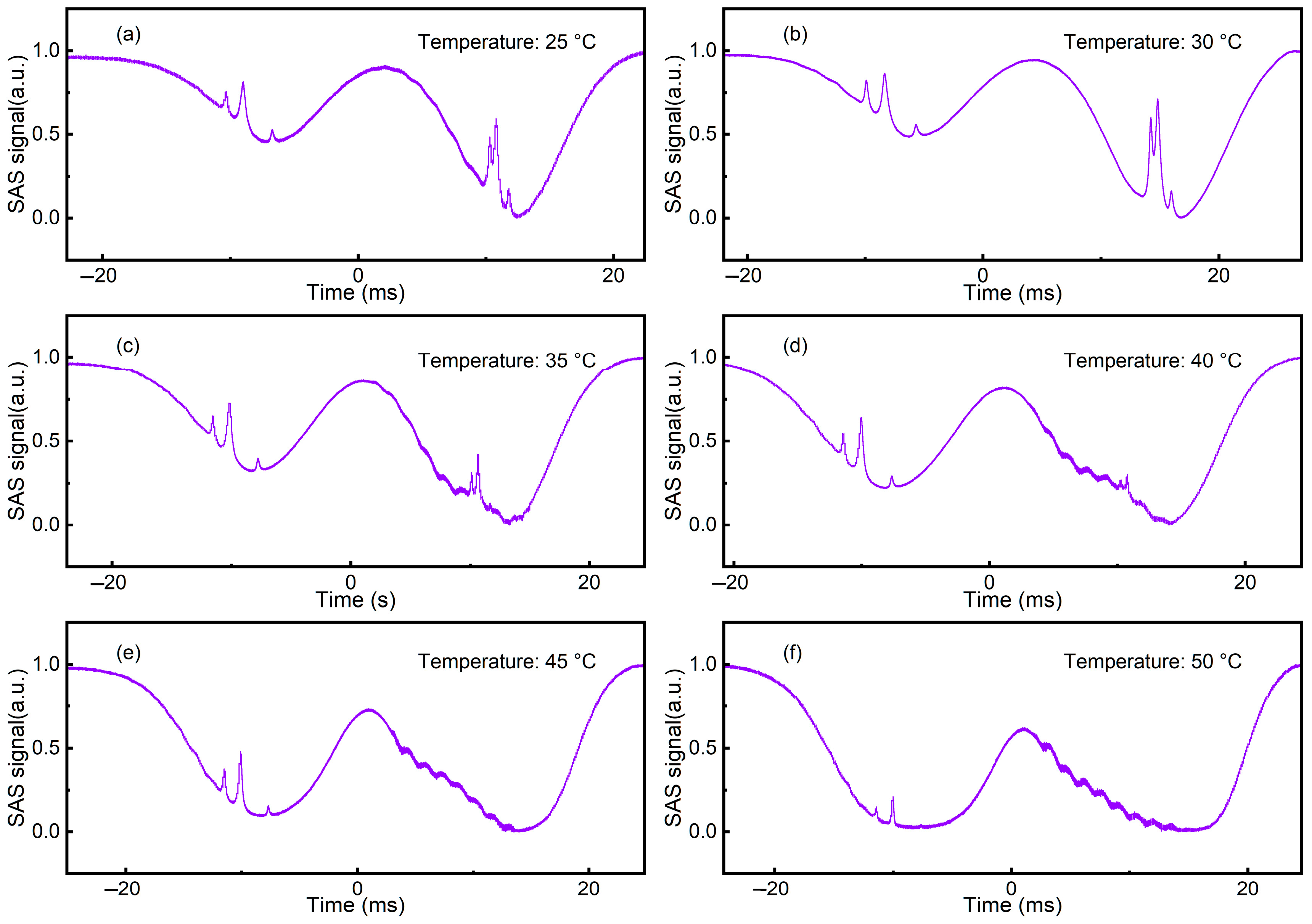
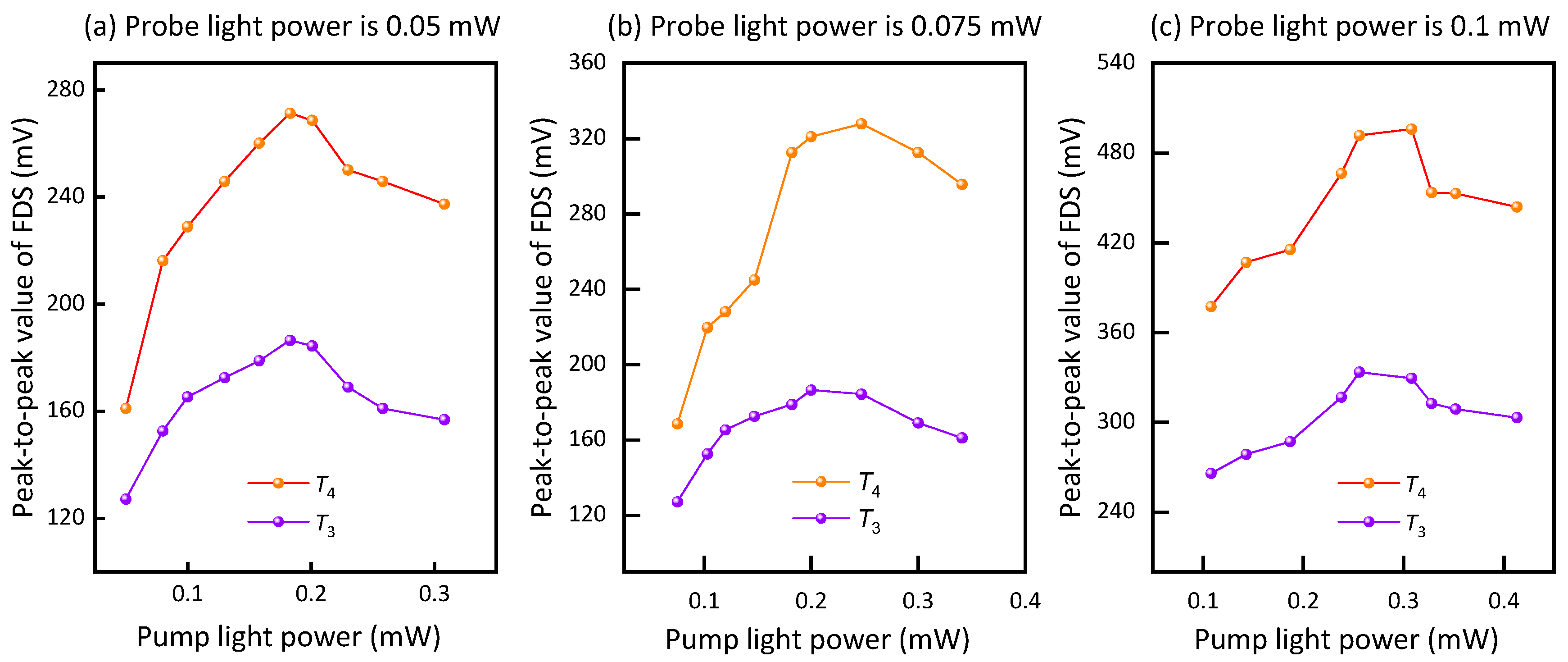
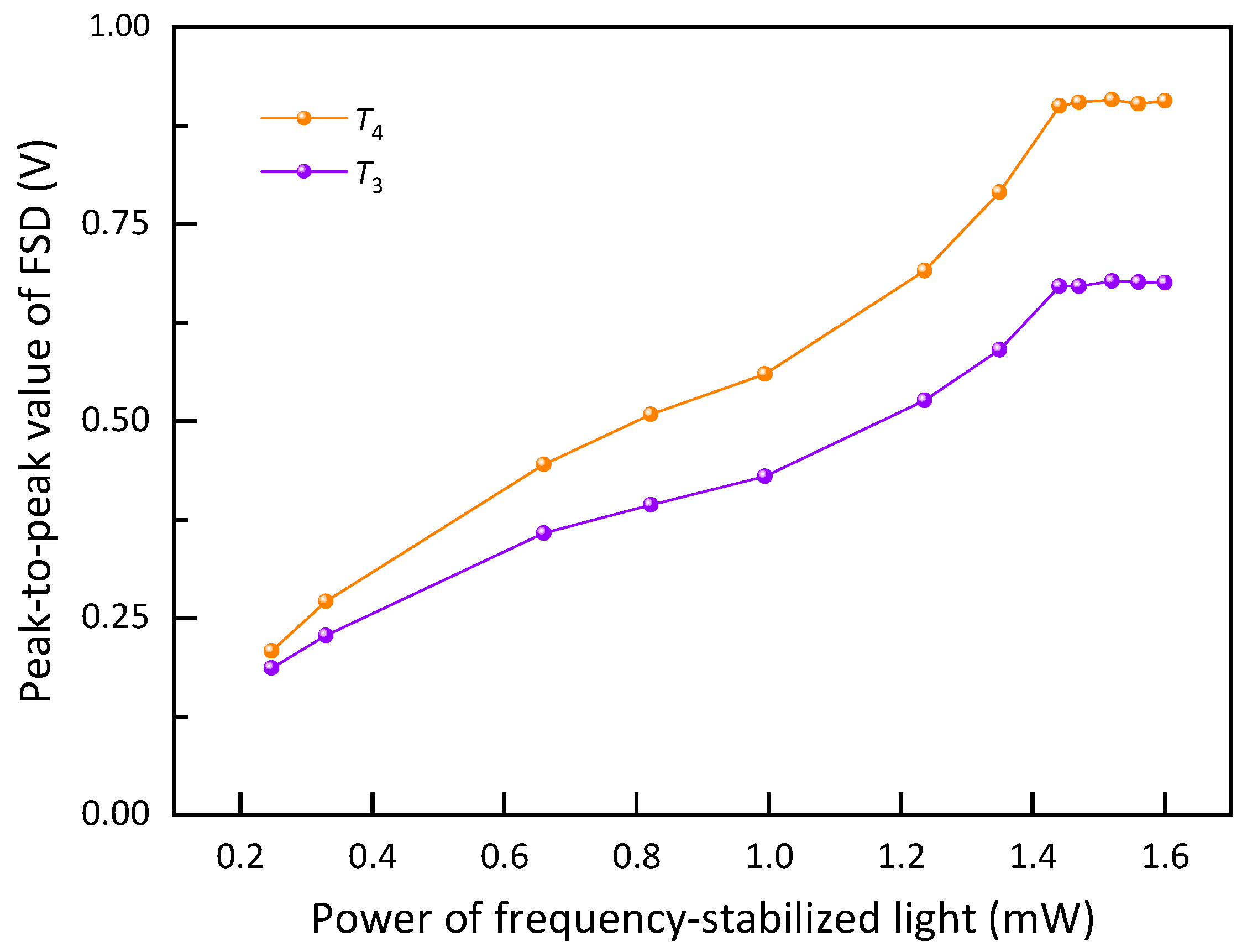
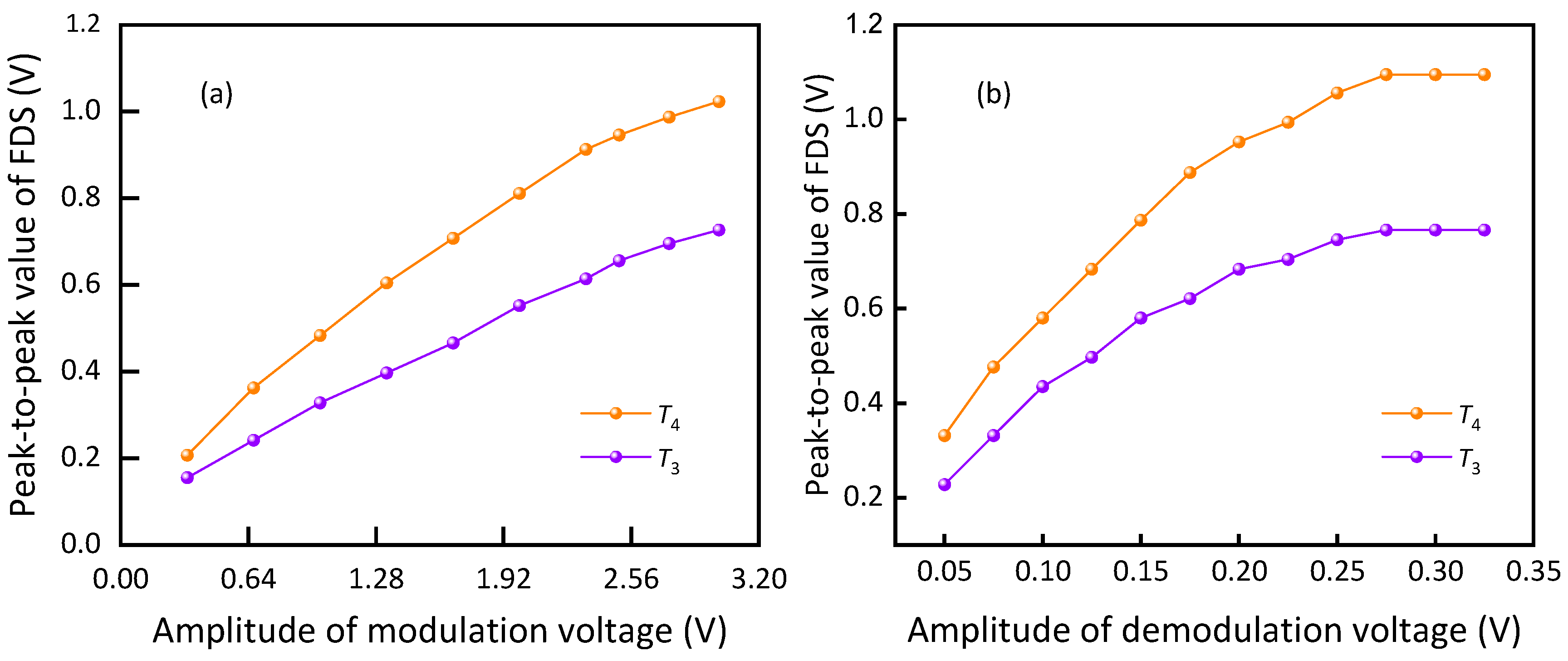
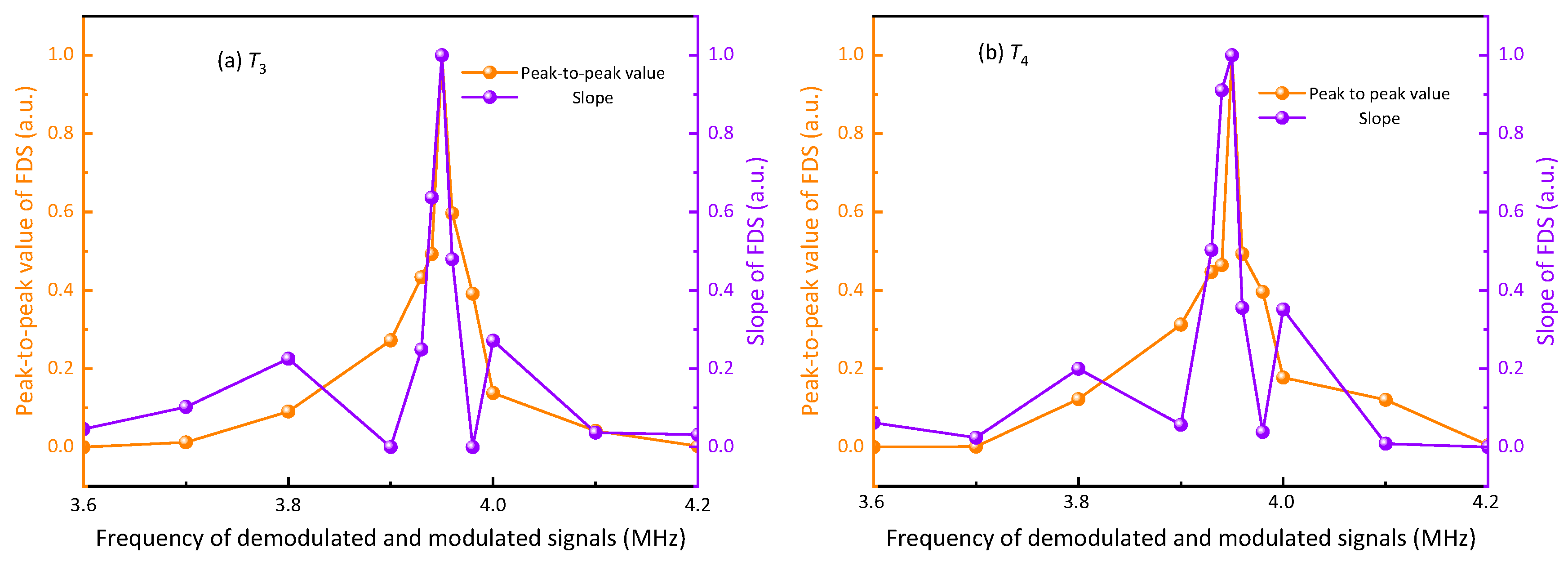

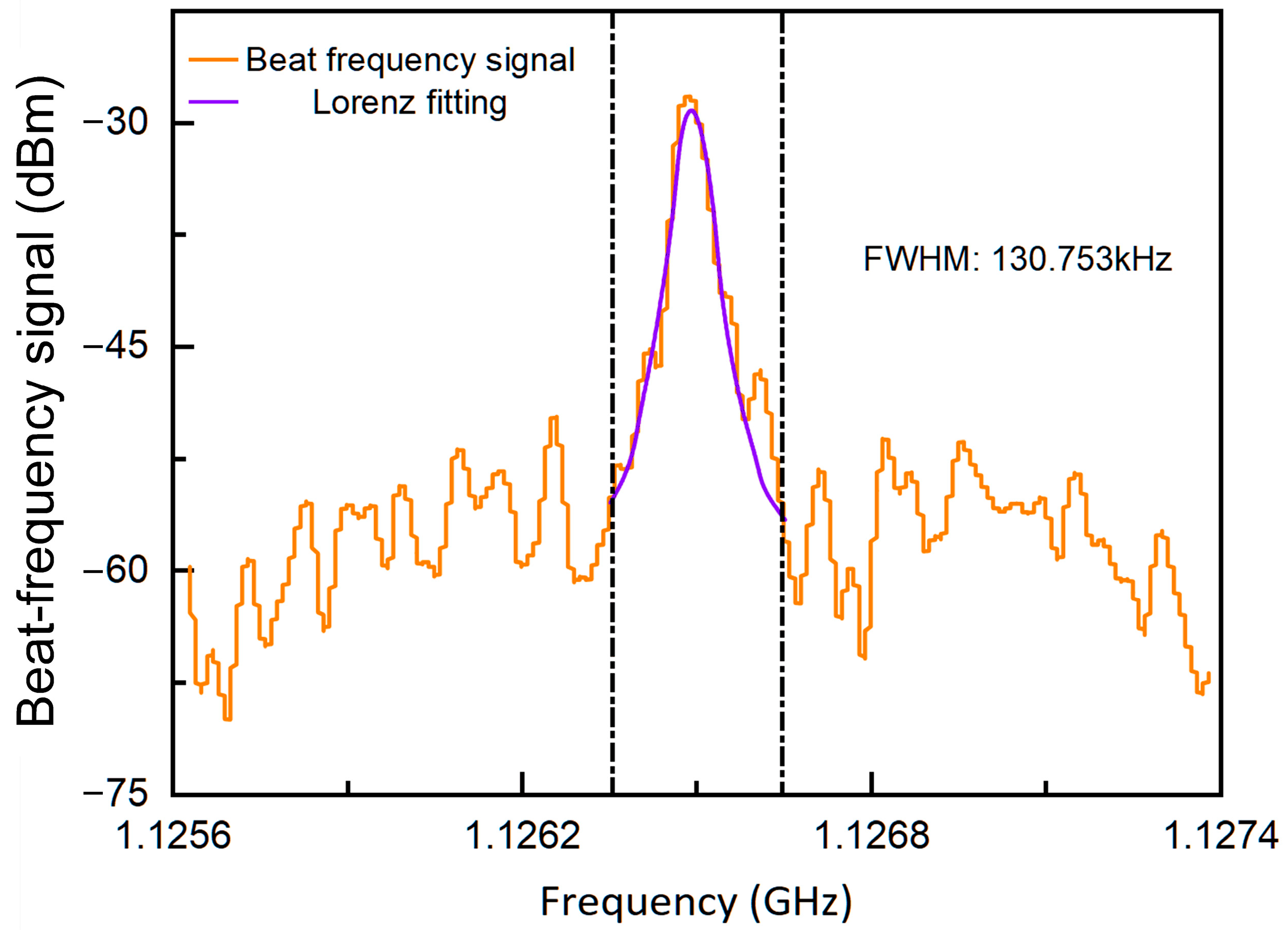
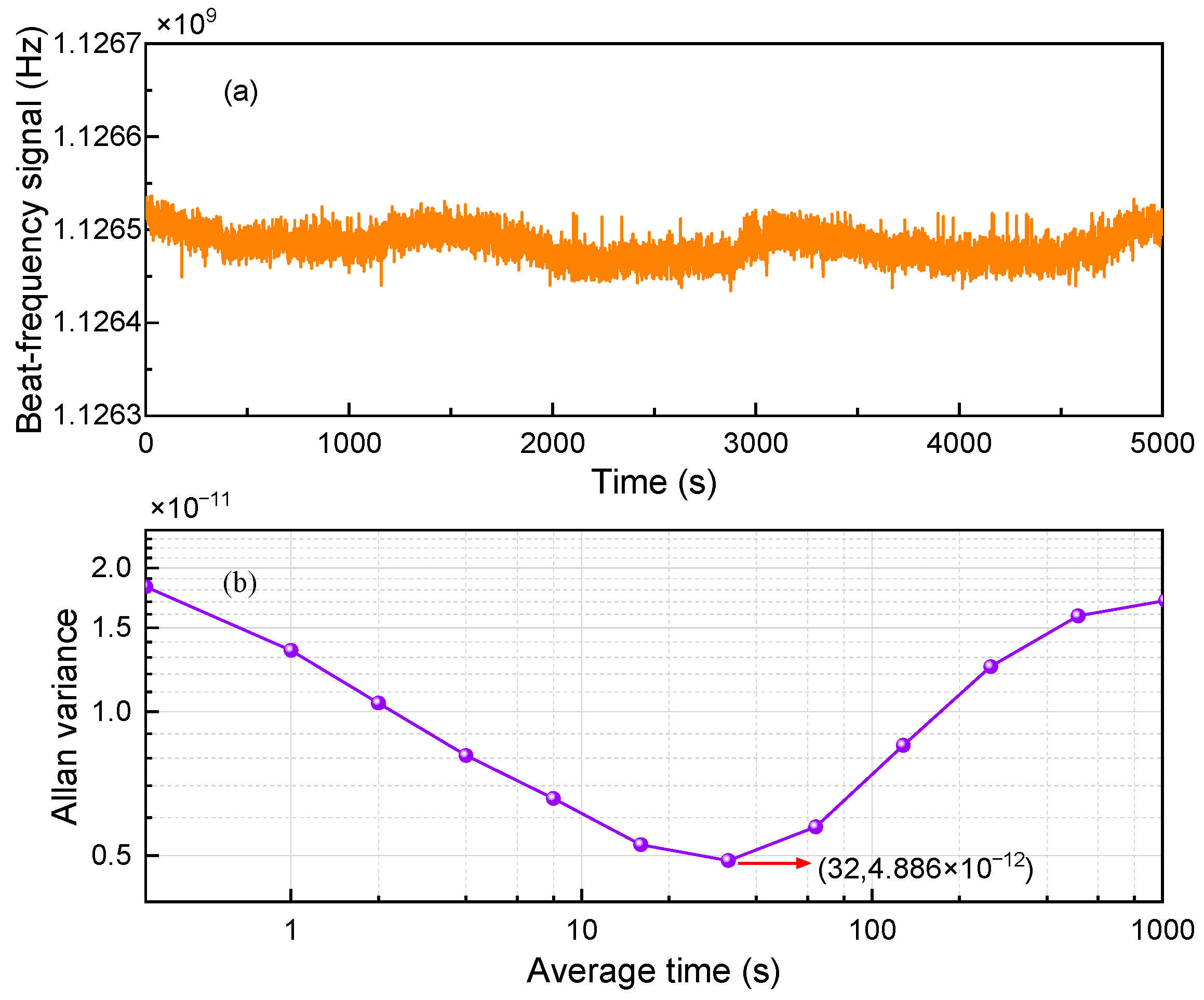

Disclaimer/Publisher’s Note: The statements, opinions and data contained in all publications are solely those of the individual author(s) and contributor(s) and not of MDPI and/or the editor(s). MDPI and/or the editor(s) disclaim responsibility for any injury to people or property resulting from any ideas, methods, instructions or products referred to in the content. |
© 2024 by the authors. Licensee MDPI, Basel, Switzerland. This article is an open access article distributed under the terms and conditions of the Creative Commons Attribution (CC BY) license (https://creativecommons.org/licenses/by/4.0/).
Share and Cite
Wu, Y.; Qin, F.; Ding, Z.; Xu, R.; Li, D. Research on the Frequency Stabilization System of an External Cavity Diode Laser Based on Rubidium Atomic Modulation Transfer Spectroscopy Technology. Photonics 2024, 11, 298. https://doi.org/10.3390/photonics11040298
Wu Y, Qin F, Ding Z, Xu R, Li D. Research on the Frequency Stabilization System of an External Cavity Diode Laser Based on Rubidium Atomic Modulation Transfer Spectroscopy Technology. Photonics. 2024; 11(4):298. https://doi.org/10.3390/photonics11040298
Chicago/Turabian StyleWu, Yueyang, Fangjun Qin, Zhichao Ding, Rui Xu, and Dongyi Li. 2024. "Research on the Frequency Stabilization System of an External Cavity Diode Laser Based on Rubidium Atomic Modulation Transfer Spectroscopy Technology" Photonics 11, no. 4: 298. https://doi.org/10.3390/photonics11040298
APA StyleWu, Y., Qin, F., Ding, Z., Xu, R., & Li, D. (2024). Research on the Frequency Stabilization System of an External Cavity Diode Laser Based on Rubidium Atomic Modulation Transfer Spectroscopy Technology. Photonics, 11(4), 298. https://doi.org/10.3390/photonics11040298



